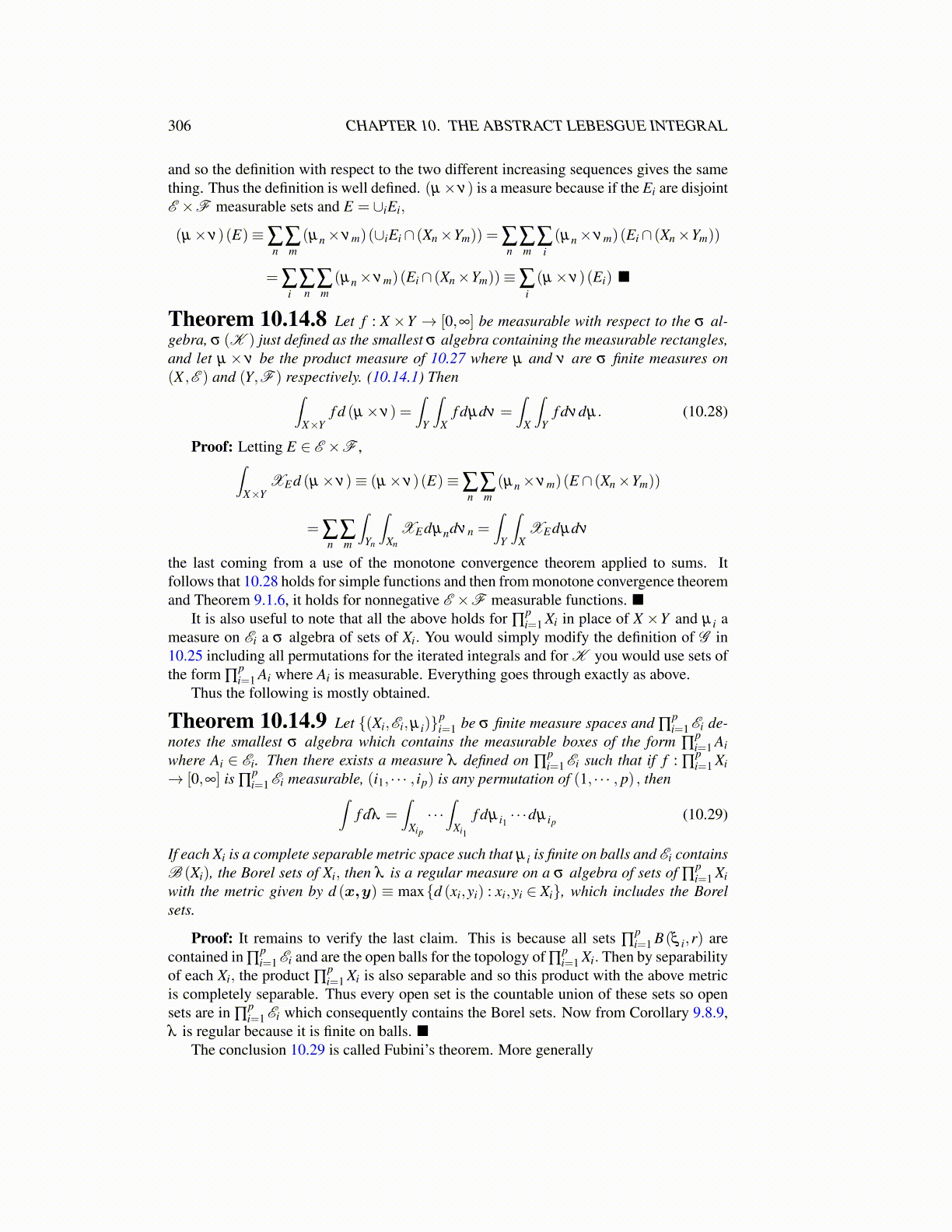
306 CHAPTER 10. THE ABSTRACT LEBESGUE INTEGRAL
and so the definition with respect to the two different increasing sequences gives the samething. Thus the definition is well defined. (µ×ν) is a measure because if the Ei are disjointE ×F measurable sets and E = ∪iEi,
(µ×ν)(E)≡∑n
∑m(µn×νm)(∪iEi∩ (Xn×Ym)) = ∑
n∑m
∑i(µn×νm)(Ei∩ (Xn×Ym))
= ∑i
∑n
∑m(µn×νm)(Ei∩ (Xn×Ym))≡∑
i(µ×ν)(Ei) ■
Theorem 10.14.8 Let f : X ×Y → [0,∞] be measurable with respect to the σ al-gebra, σ (K ) just defined as the smallest σ algebra containing the measurable rectangles,and let µ × ν be the product measure of 10.27 where µ and ν are σ finite measures on(X ,E ) and (Y,F ) respectively. (10.14.1) Then∫
X×Yf d (µ×ν) =
∫Y
∫X
f dµdν =∫
X
∫Y
f dνdµ. (10.28)
Proof: Letting E ∈ E ×F ,∫X×Y
XEd (µ×ν)≡ (µ×ν)(E)≡∑n
∑m(µn×νm)(E ∩ (Xn×Ym))
= ∑n
∑m
∫Yn
∫Xn
XEdµndνn =∫
Y
∫X
XEdµdν
the last coming from a use of the monotone convergence theorem applied to sums. Itfollows that 10.28 holds for simple functions and then from monotone convergence theoremand Theorem 9.1.6, it holds for nonnegative E ×F measurable functions. ■
It is also useful to note that all the above holds for ∏pi=1 Xi in place of X ×Y and µ i a
measure on Ei a σ algebra of sets of Xi. You would simply modify the definition of G in10.25 including all permutations for the iterated integrals and for K you would use sets ofthe form ∏
pi=1 Ai where Ai is measurable. Everything goes through exactly as above.
Thus the following is mostly obtained.
Theorem 10.14.9 Let {(Xi,Ei,µ i)}pi=1 be σ finite measure spaces and ∏
pi=1 Ei de-
notes the smallest σ algebra which contains the measurable boxes of the form ∏pi=1 Ai
where Ai ∈ Ei. Then there exists a measure λ defined on ∏pi=1 Ei such that if f : ∏
pi=1 Xi
→ [0,∞] is ∏pi=1 Ei measurable, (i1, · · · , ip) is any permutation of (1, · · · , p) , then∫
f dλ =∫
Xip
· · ·∫
Xi1
f dµ i1 · · ·dµ ip(10.29)
If each Xi is a complete separable metric space such that µ i is finite on balls and Ei containsB (Xi), the Borel sets of Xi, then λ is a regular measure on a σ algebra of sets of ∏
pi=1 Xi
with the metric given by d (x,y) ≡ max{d (xi,yi) : xi,yi ∈ Xi}, which includes the Borelsets.
Proof: It remains to verify the last claim. This is because all sets ∏pi=1 B(ξ i,r) are
contained in ∏pi=1 Ei and are the open balls for the topology of ∏
pi=1 Xi. Then by separability
of each Xi, the product ∏pi=1 Xi is also separable and so this product with the above metric
is completely separable. Thus every open set is the countable union of these sets so opensets are in ∏
pi=1 Ei which consequently contains the Borel sets. Now from Corollary 9.8.9,
λ is regular because it is finite on balls. ■The conclusion 10.29 is called Fubini’s theorem. More generally